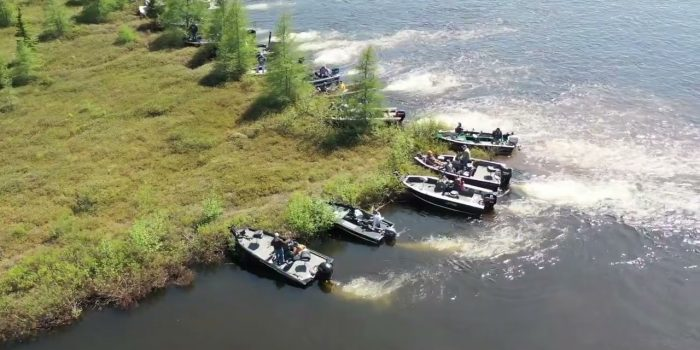
Lake Chippewa was born in 1923 when a vast swamp (沼泽地) was transformed through flooding. Following this transformation, nature started its journey. Peat bogs (泥炭沼泽), once submerged, gradually rose to the surface, creating ideal conditions for the growth of plant seeds carried by wind and birds. Over the years, the lake’s landscape evolved as grasses and trees found a foothold. Surprisingly, the roots of these plants caused the floating bogs to expand.
Today, these floating islands come in various sizes. The grandest of them is the famous “Forty Acre Bog”, on the lake’s western side. Almost annually, a heartwarming and impressive scene appears on Lake Chippewa as dozens of local boat owners join forces to push the floating island away from a bridge connecting the lake’s East and West sides. “It’s almost every year. It takes a community effort, and you must have the winds at your back to push them in,” remarked a resident. For the locals, keeping an eye on the whereabouts of the floating island has become a daily habit. “It’s one of the first things you look for when you come in here in the morning: Where’s the bog?” shared a resident.
Although the decades-old floating island does not relocate (迁移) constantly, when it does, it presents challenges for the community by obstructing the vital bridge that serves as the only passage between the lake’s East and West sides. To resolve this issue, boat owners unite. Last year, 25 boats successfully pushed the floating island away from the bridge.
These floating islands, such as the Forty Acre Bog, are legally protected and home to diverse animal species. Therefore, they cannot be disrupted, highlighting the delicate balance between human convenience and environmental conservation.
The annual actions of relocating Lake Chippewa’s floating island is a testament (证明) to the coexistence of humanity and nature, a heartwarming display of community unity, and a reminder of the importance of preserving the unique habitats that enrich our world.
1.What made the floating islands become larger in size?
A The flood.
B The wind.
C The birds.
D The plants.
解析:选D。D细节理解题。根据第一段最后一句“Surprisingly, the roots of these plants caused the floating bogs to expand.”可知,这些植物的根使漂浮的沼泽扩大了。故选D。
2.What consequence does the relocation of “Forty Acre Bog” bring about?
A Some local boats are hit.
B Locals are often looking for it.
C The traffic is obstructed.
D A new bridge is needed.
解析:选C。C细节理解题。根据第三段第一句的“Although the decades-old floating island does not relocate constantly, when it does, it presents challenges for the community by obstructing the vital bridge that serves as the only passage between the lake’s East and West sides.”可知,浮岛有时会随风飘荡到连接湖两岸的桥梁,被浮岛包围的桥梁是连接湖东岸和西岸的唯一通道,一旦桥梁被浮岛堵塞,将对当地社区的交通带来极大的不便。故选C。
3.What does the underlined word “disrupted” probably mean?
A Negotiated.
B Applauded.
C Damaged.
D Exploited.
解析:选C。C词义猜测题。根据划线部分前面的“These floating islands, such as the Forty Acre Bog, are legally protected and home to diverse animal species”可知,这些漂浮的岛屿受到法律保护,是各种动物物种的家园。因此,它们不能被破坏。故选C。
4.What’s the author’s attitude toward relocating Lake Chippewa’s floating island?
A Approving.
B Dismissive.
C Doubtful.
D Unclear.
解析:选A。A推理判断题。根据最后一段内容可知,作者认为一年一度的浮岛“搬迁”的集体行动证明了人类与自然的共存,是社区团结的暖心展示,也提醒人们保护丰富我们世界的独特栖息地的重要性。由此可见,作者对浮岛搬迁行动持赞赏态度。故选A。